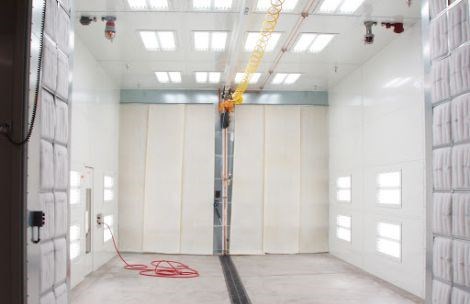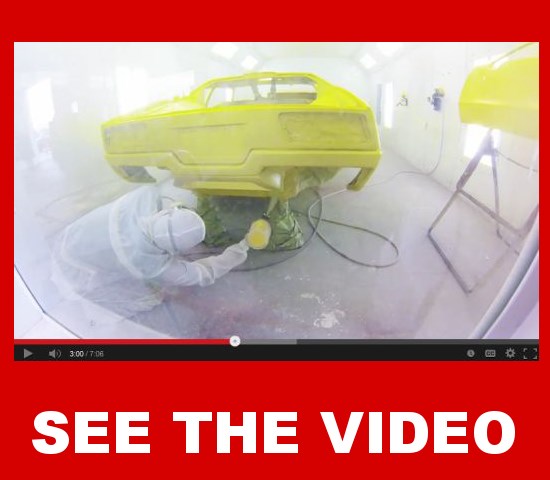8 Things You Need to Know About Paint Booth Lighting
Global Finishing Solutions has come up with some helpful insights on lighting for paints booths which plays a crucial role in achieving a quality paint job.

Global Finishing Solutions has come up with some helpful insights on lighting for paints booths. Industrial Sales Rep Jim Husby and Marketing Research Specialist Melissa Fochs say proper paint booth lighting plays a crucial role in achieving a quality paint job.
"There are many factors that go into creating a well-lit environment, including fixture quality, fixture location and type of light tube," Husby and Fochs say.
The following are a few things they say to consider when it comes to paint booth lighting.

T8 light tubes are much more energy-efficient and cost-effective than its predecessor, T12, which are no longer in production. If you have an old booth with T12 light fixtures, be sure to upgrade your booth to T8 fixtures, as you will no longer be able to purchase replacement T12 lights.
2. Color-Corrected Tubes
For many paint jobs, color matching is critical. In order to accurately color match, the lighting in the paint booth should match outdoor lighting. This is accomplished by using color-corrected light tubes.
3. Color Rendering Index (CRI)
The Color Rendering Index (CRI) measures lighting quality, on a scale of 0 to 100. The closer the number is to 100, the truer the color of light is. Higher CRI rated lamps should be used when quality or color matching is important. One thing to keep in mind though is that higher CRI rated lamps tend to be less energy efficient than lamps with lower CRI rating.
4. Foot Candles
The brightness of a booth can be measured in foot-candles. A candle is the intensity of light in a given direction. An ordinary wax candle has the luminous intensity of one-foot candle. The industry standard for a paint booth is 100 to 150 foot-candles at a 3-foot height. If a different foot-candle is desired, light quantity, placement and size should be adjusted.
5. Clear Tempered Lens
A clear tempered lens on the light fixture allows for clearer, more accurate lighting. Tempered glass is 4 to 5 times stronger than regular glass of equal size and thickness. It’s also much clearer than wire reinforced glass, which was previous used in GFS paint booths.
6. Energy-Efficient Dual Ballasts
An energy-saving feature, 6-tube dual ballast fixtures offer two levels of lighting. When less light is needed, such as during prep operations, you can save on energy costs by using half of the lights (3 tubes). Full lighting can be easily restored for painting operations and detail work.
7. Inside-Accessible Fixtures
Depending on your shop and booth location, it may be difficult to get at the sides or top of the booth to replace light bulbs. Inside-accessible light fixtures swing open to the inside of the booth, allowing for much easier light replacement.
8. Class I Division II Electrical 3rd Party Listing
We cannot express enough the importance of code compliance when purchasing and installing a paint booth. In addition to the booth as a whole, certain booth components must comply with national, state and local regulations. When it comes to lighting, regulatory agencies require that booth light fixtures be approved for Class I, Division II, Groups A-D.
GFS also manufactures high-efficiency high-bay fluorescent light fixtures for shops, warehouses, and manufacturing facilities. Check out gfshighbaylights.com for more information.
In this interview, Mike and Jim Ring give us some of the history of Ringbrothers, discuss their thoughts on spraying waterborne paints, provide some insight in to spraying clear coats and matte clear coats, and talk about their experiences painting cars in their GFS PERFORMER paint booth.
Related Content
Hubbard-Hall Acquires BioConversion Technology
The acquisition adds experience and biologics to the AquaPure product line.
Read MoreExplore Cleaning Chemistry, Metal Finishing Applications and Wastewater Treatment Solutions
Hubbard-Hall Celebrating 175 years of excellence, Hubbard-Hall presents chemistry and equipment.
Read MoreZinc Phosphate: Questions and Answers
Our experts share specific questions about zinc phosphate and pretreatment
Read MoreNASF/AESF Foundation Research Project #122: Electrochemical Approaches to Treatment of PFAS in Plating Wastewater - 9th Quarterly Report
The NASF-AESF Foundation Research Board selected a project addressing the problem of PFAS and related chemicals in plating wastewater streams. This report covers the ninth quarter of work (January-March 2023). In this report, we describe our work on evaluating the performance of PFAS degradation by electrooxidation using surface fluorinated Ti4O7 anodes in batch mode.
Read MoreRead Next
A ‘Clean’ Agenda Offers Unique Presentations in Chicago
The 2024 Parts Cleaning Conference, co-located with the International Manufacturing Technology Show, includes presentations by several speakers who are new to the conference and topics that have not been covered in past editions of this event.
Read MoreEpisode 45: An Interview with Chandler Mancuso, MacDermid Envio Solutions
Chandler Mancuso, technical director with MacDermid Envio discusses updating your wastewater treatment system and implementing materials recycling solutions to increase efficiencies, control costs and reduce environmental impact.
Read MoreEducation Bringing Cleaning to Machining
Debuting new speakers and cleaning technology content during this half-day workshop co-located with IMTS 2024.
Read More










.jpg;maxWidth=300;quality=90)










